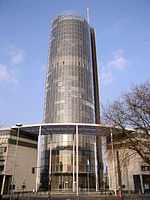RWE
| Company type | Aktiengesellschaft |
|---|---|
| FWB:RWE FWB:RWEA(ADR) DAXcomponent (RWE) | |
| ISIN | DE0007037129 |
| Industry | Electricity generation |
| Founded | 25 April 1898 |
| Headquarters | Essen,Germany |
Area served | Asia-Pacific
Europe United States |
Key people | Markus Krebber(President andCEO),Manfred Schneider(Chairmanof thesupervisory board) |
| Products | Electricity |
| Revenue | €13.125 billion (2019)[1] |
| €1.267 billion (2019)[1] | |
| €1.210 billion (2019)[1] | |
| Total assets | €39.846 billion (2019)[1] |
| Total equity | €5.738 billion (2019)[1] |
| Owner | Qatar Investment Authority(9.09%) |
Number of employees | 19,792 (2019)[1] |
| Website | www |
RWE AGis a German multinationalenergy companyheadquartered inEssen.It generates and trades electricity in the Asia-Pacific region, Europe and the United States.[2]
In July 2020, RWE completed a far-reaching asset swap deal withE.ONfirst announced in 2018, whereby the international renewable generation portfolio of E.ON and Innogy were transferred to RWE.[3]
History
[edit]Pre-World War I
[edit]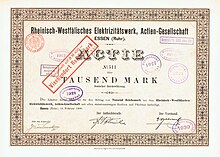
The company was founded inEssenin 1898, asRheinisch-Westfälisches Elektrizitätswerk Aktiengesellschaft(Rhenish-Westphalian Power Plant) by Elektrizitäts-Actien-Gesellschaft vorm. W. Lahmeyer & Company (EAG) and others.[4][5]The full name was used until 1990 when it was renamed to RWE AG.[6]Its first power station started operating in Essen in 1900.[5]In 1902, EAG sold its shares to a consortium formed by Ruhr industrialistsHugo StinnesandAugust Thyssen.[5]
In 1906, it expanded its operations beyond Essen by acquiring Elektrizitätswerk Berggeist AG inBrühl,and Bergische Elektrizitätswerke GmbH,Solingen.During the same year, it also acquired shareholdings in the tramway companies Bochum-Gelsenkirchener Straßenbahn AG and Rheinische Bahngesellschaft AG.[5]
In 1908, RWE signed demarcation contracts with Städtische Elektrizitätswerk Dortmund and Elektrizitätswerk Westfalen AG.[4]Together they created Westfälische Verbands-Elektrizitätswerk AG. RWE contributed to the newly established company by its power station in Dortmund–Kruckel and the supply grid in Witten/Dortmund. Later all these companies formed Vereinigte Elektrizitätswerke Westfalen AG (VEW).[5]
In 1909, RWE opened the Reisholz Power Plant and acquired a stake in the tram company Süddeutsche Eisenbahngesellschaft AG.[5]RWE also started to build its own gas supply network in 1909. Deliveries ofcoal gasto the Bergisches Land region started in 1912.[5]In 1914, RWE opened Vorgebirgszentrale power plant inHürth.By 1920, the plant had installed capacity of 190 megawatts, which made it the largest in Europe.[5]
BeforeWorld War I,municipalities of Essen,Mülheim an der Ruhr,andGelsenkirchen,became shareholders in RWE.[4]By the 1920s,Bonn,Cologne,Krefeld,Duisburg,andDüsseldorfalso became shareholders and municipalities owned the majority of RWE's shares.[5]In 1925, thePrussian statebecame a shareholder in RWE. In 1929, municipalities and theRhine Provincecombined their shareholdings into a holding company Kommunale Aufnahmegruppe für Aktien GmbH.[7]
Interwar years and World War II
[edit]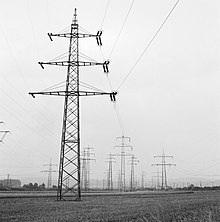
In 1920, RWE acquired Niedersächsische Kraftwerke AG, located inOsnabrück.[5]In 1922, it expanded its coal business by acquiring threeanthracitemines in Essen and a majority stake in thelignitecompany Braunkohlen- und Briketwerke Roddergrube AG.[7]In 1923, it acquired its founder company EAG. Three years later, the company acquired a stake in Rheinische Elektrizitäts-Aktiengesellschaft (Rheinelektra) and became a shareholder in the newly establishedRuhrgasgas company in exchange of its gas grid. In 1927, RWE andPrussiaswapped their holdings in theBrunswickandColognecoalfields and RWE became an owner of Braunkohlen-Industrie AG Zukunft.[7]
In 1932, RWE acquired a majority stake in the coal company Rheinische Aktiengesellschaft für Braunkohlenbergbau (Rheinbraun).[4]In 1936, it acquired Niederrheinische Braunkohlenwerke AG, an operator of theFrimmersdorf Power Plant.[8]
On 1 May 1933, the executive board includingErnst Henkejoined theNSDAPas a unified body.
Since autumn 1943, the Essen state police had been investigating Wilhelm Ricken, RWE's technical director and designated general director, for "subversion of the military". The then First Mayor of Essen, Just Dillgardt, who was also second chairman of RWE's supervisory board, had reported Ricken to the state police. Previously, he had received a tip from the then commercial director and fellow board member of Ricken, Friedrich Praedel. This "board member" of RWE is said to have pushed Dillgardt to press charges. Wilhelm Ricken was then arrested on 20 October 1943, and sentenced to death on 8 March 1944, by the Volksgerichtshof (People's Court), partly because of his statement that "the war would end like 1918". On 2 May 1944, Wilhelm Ricken was executed in Berlin-Plötzensee.[9]
In 2015, a "stumbling block"was placed at this final address in Essen to commemorate Ricken's fate.[9]
Developments since World War II
[edit]During World War II, the infrastructure owned by RWE was severely damaged but mostly repaired by 1948.[4][8]In 1952, the company was excluded from theAllies'control. In 1957, RWE acquired the coal company Neurath AG.[4]
RWE and the Bavarian state-owned 'Bayernwerk' joined forces to build Germany's first industrialnuclear reactor.The Kahl experimental nuclear power plant (15 megawatts), constructed right next to RWE's Dettingen hard coal fired power plant, supplied its first electricity in 1962. Until its closure in 1985, this plant would serve as a source of important findings which supported the design and operation of commercial nuclear reactors.
RWE's nuclear operations started in 1961, when RWE and Bayernwerk (now part ofE.ON) started to build the first German industrial nuclear reactor—theKahl Nuclear Power Plant.In 1962, they started to build the Gundremmingen Nuclear Power Plant.[10]In 1965, at the request of the surrounding municipalities, the Karnap power plant in Essen started to burn domestic waste.[10]
In 1969, RWE acquired a stake inGelsenkirchener Bergwerks-Aktiengesellschaftwhich allowed its expansion into the oil industry. However, in 1974, it was sold toVEBA AG.[11]
In 1971, foundedGesellschaft für elektrischen Straßenverkehr,a company to develop an electric car for commercial scale production. The prototype presented in 1983 was produced in cooperation withVolkswagenand namedCity-Stromer.[11]
In 1988, RWE again expanded into the oil industry by acquiring Deutsche Texaco, formerly known as Deutsche Erdoel AG, which was renamed RWE-DEA AG für Mineralöl und Chemie (RWE-DEA). RWE was reorganized to hold energy, mining and raw materials; petroleum and chemicals; waste management; mechanical and plant engineering; and construction divisions.[4]
In the 1990s, RWE acquired a number of assets in the formerEast Germany,including stakes in the mining company Lausitzer Braunkohle AG (LAUBAG) and the power company VEAG. In 2000, RWE and VEW merged to create a "new" RWE, and stakes in LAUBAG and VEAG (now both merged intoVattenfall Europe) were sold to avoid competition violation.[12]
In 2001, RWE took over the British companyThames Water.[13]In 2002, it acquired American Water Works Company, based in New Jersey, which became a subsidiary of Thames Water.[12]In 2006, RWE sold Thames Water to Kemble Water Limited, a consortium led byMacquarie Group.[14]RWE previously ownedAmerican Water,the United States' largest investor-owned water utility, but this was divested in 2008.
In 2002, RWE acquired the British electricity and gas utility company Innogy for £3 billion (US$4.3 billion). Innogy was subsequently renamed RWE npower plc.[15][16]
As a result of the assets swap withRAG AG,RWE gave away its stake in the power companySTEAG.It received almost full control of the renewable energy company Harpen AG. The full control of Harpen was achieved in 2005.[12]In 2003, RWE also achieved full control over Thyssengas. In the same year, it decided to divest its American coal companyConsol Energy.[12]
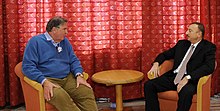
In 2011, RWE unbundled its transmission system by selling its majority stake in the transmission system operatorAmprion(RWE Transportnetz Strom GmbH), but keeping 25.1% in the company.[12][17]
On 14 August 2012, RWE AG announced that the company would cut 2,400 more jobs to reduce costs. Previously the company had announced to eliminate 5,000 jobs and 3,000 jobs through divestments as anticipated of closing all nuclear reactors by 2022.[18]
In August 2013, RWE completed the disposal of NET4GAS, the Czech gas transmission network operator, for €1.6billion to a consortium consisting ofAllianzandBorealis.[19]The company (named Transgas A.S. then) was privatized to RWE in 2002.[12]In the 2000s, RWE also acquired energy companies in Poland (STOEN S.A.) and Slovenia (VSE a.s).[12]
It also owned RWE Dea (nowDEA AG), which produced some of the oil and gas RWE sold (annual production is around 2 million m3of crude oil (about 365,000BOE) ) and 3 billion m3of natural gas (about 18 million BOE, 49,300 BOE) a day.[20]In March 2015, RWE closed the sale of RWE Dea to a group led by Russian billionaireMikhail Fridmandespite opposition from UK regulators. The $5.6 billion deal, announced in 2014, required approval from 14 countries where RWE Dea operates in Europe, the Middle East and Africa.[21]
On 1 April 2016, RWE transferred its renewable, network and retail businesses into a separate company namedInnogy,which is listed at theFrankfurt Stock Exchange.[22][23]The new entity combined RWE subsidiaries RWE Innogy, RWE Deutschland, RWE Effizienz, RWE Vertrieb and RWE Energiedienstleistungen.[24]
In March 2018, it was announced thatE.ONwill acquire Innogy in a complex €43 billion deal of assets swap with RWE. As a result, RWE will take a 16.7% stake in E.ON.[25]Following the purchase of E.ON's renewables business and nuclear electricity generation assets, RWE is expected to become Europe's third-largest renewable energy provider behind Spain'sIberdrolaand Italy'sEnel,[26]and the second-largest in the market for offshore wind power.[27]
On 1 December 2023, it was agreed that RWE would part of an £11 billion investment in the UK'sDogger Bank wind farmproject.[28]
The German government received EU approval in late 2023 for a €2.6 billion compensation payment to RWE to phase out lignite in the Rhine region. No details of the deal, or its timing, have been released.[29]
Financial data
[edit]| Year | Revenue | Net Income | Employees |
|---|---|---|---|
| 2013 | 54,070 | 66,341 | |
| 2014 | 48,468 | 61,715 | |
| 2015 | 48,599 | 59,350 | |
| 2016 | 45,833 | 59,073 | |
| 2017 | 44,585 | 59,333 | |
| 2018 | 13,406 | 17,748 | |
| 2019 | 13,125 | -660 | 19,792 |
| 2020 | 13,896 | 1,051 | 19,630 |
| 2021 | 24,761 | 721 | 18,867 |
| 2022 | 38,366 | 2,717 | 18,310 |
| 2023 | 28,566 | 1,450 | 20,315 |
Operations
[edit]
RWE operates in Asia-Pacific, Europe and the United States.[31]The group is organized around four core areas:
- Offshore Wind
- Onshore Wind/Solar
- Hydro/Biomass/Gas
- Supply & Trading
In addition to these core areas, there is a Coal/Nuclear segment.
In the UK, RWE fully owns RWE Generation UK plc., which operates a number of natural gas and renewable energy power stations across the UK. RWE's last coal-fired power station in the UK,Aberthaw Power Stationin South Wales, was closed in March 2020.[32]The company owns the gas-fired power stationsStaythorpein Nottinghamshire,Pembrokein West Wales,Little Barfordin Bedfordshire,Great Yarmouthin Norfolk, andDidcot 'B' Stationin Oxfordshire. It has previously closed itsDidcot 'A' Power Stationin Oxfordshire,Littlebrook Power Stationin Kent,Fawley Power Stationin Hampshire, andTilbury Power Stationin Essex.[33]
RWE jointly owns one third of theUrenco GroupwithE.ON.The remaining stakes are held by theBritishandDutchgovernments, with one-third each.[34]
Fuel mix disclosure
[edit]In 2019, RWE produced a total of 153.2 TWh of electricity from the following sources: 33.2%natural gas,32%lignite,13.8%nuclear power,10.7%renewables,9.3%hard coaland 1.2%pumped storage.In 2019, the company generated 88.1Mtof CO2.[35]Electricity production at the German branch of RWE had the following environmental implications in 2006: 700 μg/kWhradioactive wasteand 752 g/kWhCO2emissions.[36][37][38]In 2007, the company ranked between the 28th and the 29th place of emitters by country.
Criticism and controversies
[edit]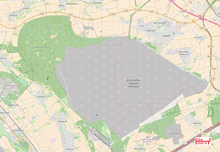
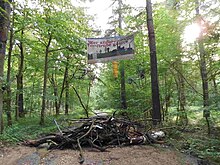
RWE has long been among the top targets of climate activists, in part as a result of a long-running, high-profile battle to preserve a forest in western Germany that is threatened by the planned expansion of one of the group'scoal mines.RWE also operates some of the largestcoal-fired power stationsin Europe.[27]
In 2018, RWE was the largest producer ofcarbon dioxide emissionsin Europe.[27]
Since 2012, environmentalists have protested against RWE because of theHambach surface minesituated in the area ofHambach Forest.[40]In November 2017, in the lawsuit filed byBund für Umwelt und Naturschutz Deutschland(BUND), the German arm ofFriends of the Earth,the Higher Administrative Court inMünsterruled to end the tree cutting. According to BUND, Hambach Forest is a habitat type 9160 of annex I of the EuropeanHabitats Directive(Council Directive 92/43/EEC of 21 May 1992).[41]
Opponents also argue that anenvironmental impact assessmentstudy for the mine was never conducted. The Administrative Court inColognedenied the necessity of such a study in November 2017, because the permission for the mining operations was given in the 1970s, long before environmental impact assessment studies became mandatory.[42]In October 2018, an estimated 50,000 protesters turned out against the company's planned continued forest clear-cutting for its open-pit coal mine expansion while a court order delayed the process until at least late 2020, to explore if it violated EU environmental regulations.[43][44]
In September 2021, it was revealed that RWE are among a number of fossil fuel companies suing governments for enacting green policies againstclimate change.RWE are suing the Dutch government for $1.6bn following their move to phase out and shut down coal power plants.[45]
Sponsorship
[edit]Between 2000 and 2007, RWE was the main kit sponsor of GermanBundesligaclubBayer 04 Leverkusen.[46]
See also
[edit]References
[edit]- ^abcdef"RWE: Our energy for a sustainable life - Annual Report 2019"(PDF).RWE.Retrieved19 October2020.
- ^RWE."Introducing RWE AG".group.rwe.Retrieved20 October2020.
- ^"RWE finalises Eon asset swap deal".July 2020.
- ^abcdefg "RWE AG History".FundingUniverse.Retrieved7 April2018.
- ^abcdefghij"Chronicle 1898-1920".RWE.Retrieved7 April2018.
- ^"History of RWE AG – FundingUniverse".fundinguniverse.Retrieved20 October2020.
- ^abc"Chronicle 1921-1930".RWE.Retrieved8 April2018.
- ^ab"Chronicle 1931-1945".RWE.Retrieved8 April2018.
- ^ab"WILHELM RICKEN - Stolperstein, Essen, Germany - Stolpersteine on Waymarking".waymarking.Retrieved25 November2019.
- ^ab"Chronicle 1959-1967".RWE.Retrieved8 April2018.
- ^ab"Chronicle 1968-1980".RWE.Retrieved8 April2018.
- ^abcdefg"Chronicle 2000-2008".RWE.Retrieved8 April2018.
- ^"RWE's £4bn buys Thames Water".The Scotsman.26 September 2000.Retrieved24 February2016.
- ^"Thames Water to be sold for £8bn".BBC News. 16 October 2006.Retrieved24 February2016.
- ^"Innogy agrees to German takeover".BBC News. 22 March 2002.Retrieved25 December2012.
- ^"RWE Is Set to Buy Innogy".The New York Times.18 March 2002.Retrieved25 December2012.
- ^ "RWE has no plans to sell stake in power network Amprion".Reuters.27 February 2018.Retrieved8 April2018.
- ^"RWE Announces 2,400 More Job Cuts as Power Demand Slumps".Bloomberg News.14 August 2012.
- ^RWE Annual Report 2013(PDF).RWE AG. p. 23.
- ^"RWE Dea".oilvoice.Retrieved20 October2010.
- ^"Germany's RWE closes $5 billion oil, gas unit sale despite UK opposition".Petro Global News.Retrieved2 March2015.
- ^ Chazan, Guy (7 October 2016)."Lacklustre market debut for Innogy".Financial Times.Retrieved8 October2016.
- ^ "RWE renewables spinoff Innogy volatile in market debut".Deutsche Welle.7 October 2016.Retrieved8 October2016.
- ^"RWE renewables subsidiary launched".Windpower Monthly.1 April 2016.Retrieved8 October2016.
- ^ Massoudi, Arash; Buck, Tobias (11 March 2018)."Eon to acquire Innogy in €43bn deal with RWE".Financial Times.Retrieved11 March2018.
- ^Nina Chestney (8 April 2019),UK competition authority clears RWE purchase of stake in E.ONReuters.
- ^abcTobias Buck (September 30, 2019),RWE aims to be carbon neutral by 2040Financial Times.
- ^"Sunak wraps up 11-hour Cop28 trip with new deal for UK wind farm".The Independent.1 December 2023.Retrieved1 December2023.
- ^"EU approves Germany's payments for early coal exit".Deutsche Welle.11 December 2023.
- ^"RWE Bilanz, Gewinn und Umsatz | RWE Geschäftsbericht | 703712".wallstreet-online.de.Retrieved5 November2018.
- ^RWE."RWE locations worldwide".group.rwe.Retrieved20 October2020.
- ^correspondent, Jillian Ambrose Energy (1 August 2019)."German utilities firm RWE to close its last UK coal plant in 2020".The Guardian.ISSN0261-3077.Retrieved21 October2020.
- ^"Our sites in the UK".RWE.Retrieved25 October2017.
- ^Powerhouse of the Uranium Enrichment Industry Seeks an Exit27 May 2013 NYT
- ^"RWE: Our energy for a sustainable life"(PDF).
- ^"RWE electricity label 2006".
- ^http:// rwe /web/cms/mediablob/en/614918/data/594840/4/rwe/responsibility/cr-reports/CR-Key-Figures-2010.xls[dead link]
- ^Press release Carbon Market Data:"RWE, Enel and E.ON top the list of European CO2emitters "(PDF).Archived fromthe original(PDF)on 11 April 2009.
- ^"Action Map of the Wood – Hambach Forest".
- ^"Clash in German forest as red line is crossed".Deutsche Welle.1 December 2016.Retrieved16 September2018.
- ^"Save the" Hambacher Forst "- Stop coal mining"(PDF).BUND - Friends of the Earth Germany.Retrieved15 April2018.
- ^"German activists lose bid to halt Hambach mine expansion | DW | 24.11.2017".DW.COM.Retrieved25 November2019.
- ^"Germany: Court Orders Halt to Destruction of Forest Near Coal Mine".Democracy Now!.Retrieved9 October2018.
- ^"RWE agrees to leave Hambach Forest untouched until 2020 – NRW state premier".Clean Energy Wire.20 February 2019.Retrieved25 November2019.
- ^"Fossil fuel firms sue governments across the world for £13bn as climate policies threaten profits".16 September 2021.Retrieved17 September2021.
- ^"NEWS IN BRIEF: 20 YEARS OF SHIRT ADVERTISING – BAYER CROSS MAKES WAY FOR CHAMELEON".Bayer04.Retrieved5 May2023.
Further reading
[edit]- Energy in South East Europe: Corporate Profiles on major investment firms in South East Europe (April 2004) (PDF) of the EU to the2004 enlargement of the European Union.
External links
[edit]- RWE
- Companies based in Essen
- Companies listed on the Frankfurt Stock Exchange
- Companies in the DAX index
- Electric power companies of Germany
- Nuclear power companies of Germany
- Public utilities established in 1898
- German brands
- 1898 establishments in Germany
- Multinational companies headquartered in Germany
- Coal companies of Germany

